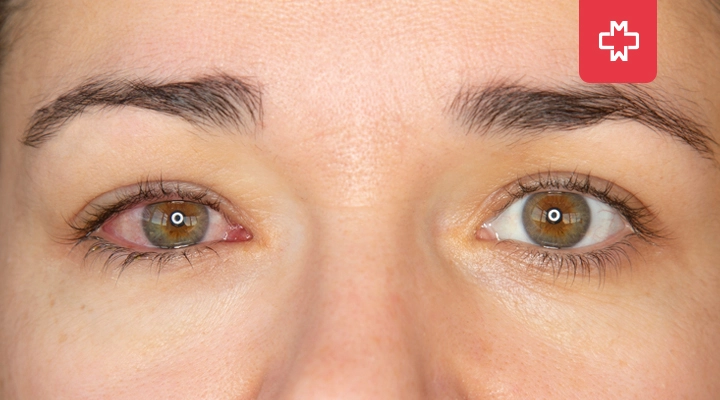Most of us have experienced waking up with red, itchy eyes and immediately thinking, “I’ve probably gotten pink eye!”
Conjunctivitis, commonly known as pink eye, is a widespread ocular condition. However, since most individuals are usually wrong, are you sure if it’s pink eye or something else?
What if I told you that what you think of as bacterial pink eye might be something else entirely?
Let’s discover the conditions that are commonly misdiagnosed as pink eye.
What is Pink Eye?
Pink eye is an inflammation of the conjunctiva – the thin, transparent layer of tissue that lines the inner surface of the eyelid, covering the white part of the eye. It can be caused by viruses, bacteria, allergens, or irritants, leading to redness, itchy eyes, blurry vision, excessive tearing, and discharge.
How To Recognize Pink Eye?
Recognizing pink eye involves observing symptoms such as redness, itchy eyes, a gritty feeling in the eye, discharge (which can be clear, white, yellow, or green), excessive tearing, and sensitivity to light. However, these symptoms persist and can overlap with other eye infections, leading to misdiagnosis.
What is Commonly Misdiagnosed as Pink Eye?
- Allergic Conjunctivitis: Often mistaken for pink eye due to similar symptoms, allergic conjunctivitis is triggered by allergens such as pollen, dust mites, or pet dander.
- Bacterial Conjunctivitis: This type of conjunctivitis, caused by bacteria, can mimic viral conjunctivitis with symptoms including redness, discharge, and crusting of the eyelids.
- Viral Conjunctivitis: Sharing symptoms with bacterial conjunctivitis, viral conjunctivitis is caused by viruses such as adenovirus and can lead to redness, excessive tearing, and discharge.
- Dry Eye Syndrome: Dry eye syndrome can present with redness, irritation, and a gritty sensation, often mistaken for bacterial pink eye, but is caused by insufficient tear production or poor tear quality.
- Contact Dermatitis: Exposure to irritants or allergens, including cosmetics, soaps, or solutions of contact lenses, can lead to contact dermatitis of the eyelids, mimicking the symptoms of pink eye.
- Styes and Chalazia: These eyelid conditions, characterized by painful, red bumps or swollen areas, can be confused with pink eye due to their similar appearance.
- Corneal Abrasions: Although primarily affecting the cornea, corneal abrasions can cause redness, excessive tearing, and discomfort, leading to misdiagnosis as pink eye.
- Herpes Simplex Virus (HSV) Infection: HSV eye infections can cause symptoms similar to conjunctivitis, including redness, pain, and discharge, necessitating careful differentiation from pink eye.
- Periorbital Cellulitis: This serious infection of the eyelids and surrounding tissues can present with redness, swelling, and warmth, potentially being mistaken for pink eye initially.
How Long Does Pink Eye Last?
The duration of pink eye can vary depending on its cause. Viral and bacterial conjunctivitis typically resolves within one to two weeks, while allergic conjunctivitis may persist as long as the allergen is present.
Causes & Symptoms of Pink Eye
– Causes of Pink Eye:
- Viral Infection: Pink eye can be caused by various viruses, including adenovirus, herpes simplex virus (HSV), and others.
- Bacterial Infection: Bacterial pink eye is often triggered by bacteria such as Staphylococcus aureus or Streptococcus pneumonia.
- Allergens: Exposure to allergens like pollen, dust mites, pet dander, or certain chemicals can provoke allergic conjunctivitis.
- Irritants: Irritants such as smoke, chemicals, or foreign bodies can irritate the conjunctiva, leading to inflammation.
- Dry Eyes: Insufficient tear production or poor tear quality can result in dry eye syndrome, predisposing individuals to pink eye.
- Contact Lenses: Improper use, hygiene, or extended wear of contact lenses can increase the risk of developing pink eye.
– Symptoms of Pink Eye:
- Redness: The primary symptom of pink eye is redness of the whites of the eyes, caused by inflammation.
- Itching: Pink eye often presents with itching or a sensation of irritation in the affected eye(s).
- Tearing: Excessive tearing or watery eyes are common symptoms of pink eye, particularly in allergic conjunctivitis.
- Discharge: Pink eye may produce discharge, which can be clear, white, yellow, or green, depending on the underlying cause.
- Grittiness: Individuals with pink eye may experience a gritty sensation in their eyes, akin to having sand or grit lodged in the eye.
- Sensitivity to Light: Photophobia, or sensitivity to light, can occur in pink eye, causing discomfort in bright environments.
- Swelling: Swelling of the eyelids or conjunctiva may accompany pink eye, especially in cases of bacterial or allergic conjunctivitis.
- Blurry Vision: In severe cases or with certain types of conjunctivitis, pink eye can lead to impaired or blurry vision.
How to Treat Pink Eye?
Treatment for pink eye depends on its underlying cause. The available treatment options may include:
- Artificial tears
- Antihistamines
- Decongestants
- Antibiotics (topical or oral)
- Antiviral medications
- Warm compresses
- Avoiding triggers
Frequently Asked Questions
Does pink eye hurt?
Pink eye can cause discomfort such as itchy eyes, burning, or a gritty sensation, but it typically doesn't cause severe pain.
How long does it take to get pink eye from someone else?
The incubation period for pink eye varies depending on the cause. Viral conjunctivitis can develop within one to two days after exposure to the virus, while bacterial conjunctivitis may take longer, typically around two to four days.
What happens if pink eye goes untreated?
If left untreated, pink eye can lead to complications such as worsening symptoms, spreading to other parts of the eye, or even causing permanent vision loss. It's important to seek medical attention for proper diagnosis and treatment to prevent potential complications.
– Disclaimer –
This blog is for informational & educational purposes only and does not intend to substitute any professional medical advice or consultation. For any health-related concerns, please consult with your physician, or call 911.
-
About The Author
Dr. Syra Hanif M.D.Board Certified Primary Care Physician
Dr. Syra Hanif is a board-certified Primary Care Physician (PCP) dedicated to providing compassionate, patient-centered healthcare.
Read More







